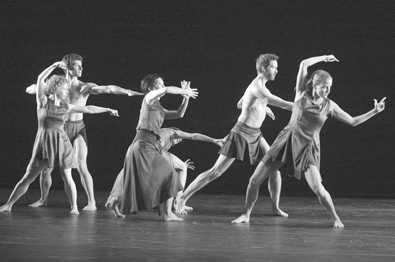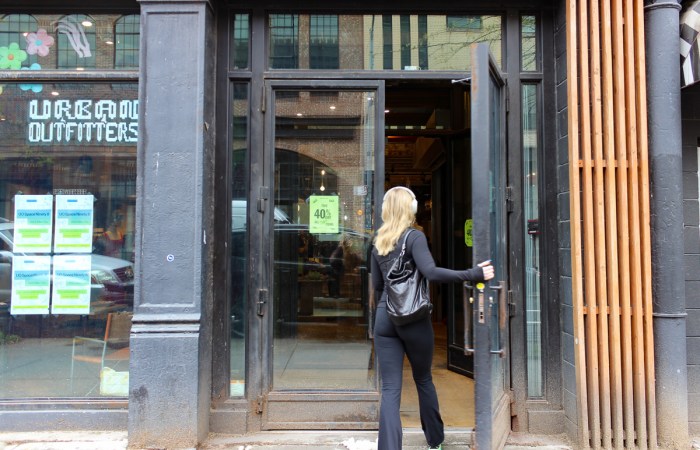Danced with disarming naturalness and flawlessly musical
BY GUS SOLOMONS JR.
The opening program of the Mark Morris Dance Group’s 25th anniversary season at BAM showed why Morris is the George Balanchine of the 21st Century. He’s arguably the most musical choreographer since the late founder of the New York City Ballet, and to his credit, he insists on always performing to live music. Also, like Mr. B,
Morris choreographs the intricacies of internal structure of the music, not just its obvious rhythms.
The first program—there will be a different one each week—opened with “V” (2004), using Shumann’s “Quintet in E flat for piano and strings” as its musical scaffold. As craftily and logically as a Chinese puzzle, Morris’s patterns unfold in V-formations for a group of seven bare-legged dancers in blue tunics—smart costumes by Martin Pakledinaz; they crisscross in diagonal lines, with arms and legs thrust at 45-degree angles, and when the music recapitulates, a second team in long, pale green outfits does a mirror image of the identical movement.
In one recurring motif, a single file of dancers crosses the stage, east to west, piercing a rank, moving abreast, west to east; in another, opposing forces creep on hands and feet like stalking panthers, one group accenting on the beats and the other on the off-beats. Like a tapestry maker, Morris interweaves the greens and blues in myriad combinations of color and gender, buoyed by Schumann’s rich harmonies and soaring melodies.
The clarity of Morris’s formal designs and seemingly effortless correspondence between music and dancing give his work satisfying accessibility—and engender in some the criticism that it’s too predictable. But like Mozart, also a genius of his craft, Morris knows how to set up expectancy through repetition and then surprise you by varying it at precisely the right moment.
“Grand Duo” (1993) captures a primeval population indulging in habitual rituals. The aggressive rhythms of Lou Harrison’s 1988 “Grand Duo for Violin and Piano,” given a superb performance by violinist Jesse Mills and pianist Steven Beck, propels the savage clan. Michael Chybowski’s dramatic lighting highlights Susan Ruddie’s primitive smocks, as fourteen dancers take sides, virtually hurling clusters of strident piano chords at each other. The final section, Polka—a demented, thigh-slapping, elbow-pumping folk dance of spiraling circles and full frontal splicing lines—ends with the thrilling abruptness of jumping off a cliff.
Antonio Vivaldi’s “Gloria in D” gives Morris, who’s not dancing in the opera house programs, a chance to show off his musical chops as conductor, leading his 23-piece MMDG music ensemble, the 26-voice Juilliard Choral Union, and vocal soloists Eileen Clark and Margaret Bragle in “Gloria,” a dance premiered in 1981 at Dance Theater Workshop and revised in 1984 for BAM’s LePerq Space.
These three dances feature ensemble casts. Although everyone gets little moments to shine, there are no big solos. The dancers—all of them stars—perform with disarming naturalness, unmannered and flawlessly musical, projecting the confidence that comes from knowing how good Morris’s dances are and the exhilaration of getting to do such satisfying pieces—again and again.
gaycitynews.com



































